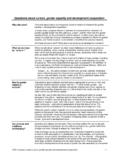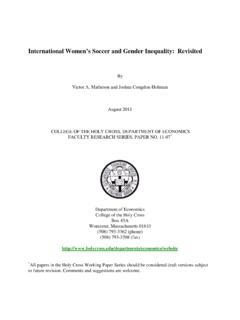Transcription of Sport, Social Division and Social Inequality - umdknes.com
1 Sport Science Review, vol. XX, No. 1-2, April 201195 Sport, Social Divisionand Social InequalityGrant JARVIEThis article examines different forms of Social Division and Social Inequality which impact upon contemporary sport. The research draws upon and contributes to contemporary sports participation data in one country. It also draws upon some examples of research from countries other than UK in order to provide a broader international perspective. It examines new forms of Inequality and some of the ways in which sport has helped to support Social change. It suggests that future researcher examining the relationship between sport and Social Inequality might think of this in at least three ways (i) Inequality of condition; (ii) Inequality of opportunity and (iii) Inequality of capability.
2 The research supports the argument that sport has a part to play in improving the life chances. The research provides a valuable comparative example from which to develop further comparative research in this : sport, Social Inequality , Social class, gender , ethnicity, Social change, life chancesIntroductionWhenever one is pondering the dynamics of Social divisions or forms of Inequality in sport it is always useful to consider who is sport and how have Social structures provided both continuity and change in sport? Undoubtedly a global gap continues to define to-days world with more than billion people living on less than $1 a day. 46% per cent of the world s population lives on less that $2 a day. The gap in Social Inequality is both between countries as well as within countries.
3 To put this in some comparative context, for the season 2003-4 the wage and transfer bill of the four English football divisions stood at 1,049 billion, a figure which eclipses the gross domestic product of some small African nations such as Lesotho and Mauritania, and could wipe out most of the debt of many countries both within and outside of Africa. The transfer of sporting Sport, Social Division and Social Inequality96capital both in terms of human and physical forms helps to sustain Social divisions between different parts of the world as well as promote the illusion or myth of Social inclusion - a much over used term. Sport, Social divisions and Social Inequality while recognizing traditional forms of 20th century forms of Inequality in sport considers the way in which sport today both reinforces forms of Social Inequality while providing a resource of hope for some people.
4 This article is structured around four themes (i) Social divisions and the new tribes which introduces new forms of Inequality in the UK based upon people s attitudes to equality and fairness; (ii) sport and Social class which eschews traditional class barriers in sport while acknowledging campaigns for change- some of which are outside of the UK; (iii) the role of gender and sporting heroines in challenging traditional forms of authority and (iv) the impact of the Obama phenomenon in the USA and in particular the part played by sport in providing a contribution to what Obama refers to as the audacity of hope. These four themes are not exhaustive of the all different forms of Social Division that permeate sport today they do nonetheless reflect upon the ways in which sport despite exaggerated claims of Social inclusion or exclusion in some countries continues to provide many possibilities within certain limits.
5 The research for this article is derived from an analysis of UK participation data which has been placed in a broader context as a basis for commenting upon sport in UK society. Social Divisions and the New TribesSocio-economic systems differ in the degree to which they constrain the rights and powers of different groups of people in different countries. The class structure in the United Kingdom is not the same as the class structure in America or Asia. Patterns of interaction between different Social divisions at times disproportionately marginalise segments of the population. In the United States of America while the class structure at the beginning of the 21st century includes an extremely rich capitalist class and corporate managerial class, living at extraordinarily high consumption standards, with fluctuating constraints on their exercise of economic power following the emergence of recession in 2008, it also reflects a pattern of interaction between race and class in which the working poor and the marginalised population are disproportionately made up of racial minorities.
6 The potential coherence of Social divisions lies in the notions of hierarchy, Social Inequality and Social injustice that permeate sport. Complex Social divisions are not just about the reality of everyday sport but rather they reinforce the fact that whatever categories are used unequal access to sport tends to continually impinge upon the same categories of people. The gap between rich and poor Sport Science Review, vol. XX, No. 1-2, April 201197remains a significant gap. Any discussion of sport and Social Inequality that relates solely to class, ethnicity gender , or any singular category fails to raise issues of poverty, capability, injustice and the precise nature of the limits and possibilities that are open to people.
7 No one single story can address every form of oppression, identity or political aspiration but sport in the world today has to be much more sensitive to the shear diversity of the multiple axes of power and Inequality . New Social divisions are emerging all the time but in the Britain of the 21st century new attitudes towards Inequality and fairness might suggest that the orthodox traditional forms of Inequality are themselves not as important as they were in the 20th century. New Social divisions are emerging. Researchers in the UK have begun to ask new questions about Social Inequality (Hampson and Olchawski, 2009). Four fairly equal clusters of opinions and groups seem to be emerging out of this recent research. The traditional egalitarians (22%) support measures to tackle Inequality at both the top and the bottom.
8 They tend to be older and more heavily weighted towards Labour with 55% in socio-economic group C2DE. The traditional free marketers (20%) oppose measures to tackle Inequality at both the top and the bottom. They are overwhelmingly in socio-economic groups ABC1 (70%) and are much more heavily weighted towards the Conservatives than the country as a whole. The angry middle (26%) support measures to tackle Inequality at the top, while opposing measures to tackle in-equality at the bottom. They are slightly more weighted towards the Conserva-tives than the country as a whole and 53% are ABC1. Finally a fourth grouping, the post ideological liberals (52%) support certain measures to tackle Inequality at the top (although they have more positive attitudes towards those at the top than Traditional Egalitarians) without having negative attitudes towards those in poverty or being opposed to tackling Inequality at the bottom (unlike the tradi-tional free marketers and the angry middle).
9 Most of the new tribes are strongly attracted to a Social vision framed around improving the quality of life for all. Sport and Social Class. Sport has long been viewed as a graphic symbol of meritocracy despite the fact that sociologists and others have been questioning the substantive basis for such a claim for more than quarter of a century. Thus the popular image of sport as an unquestioned democracy of ability and practice is somewhat over-exaggerated if not mythical. Generally speaking, the term democratisation tends to imply a widening degree of opportunity or a diminishing degree of separatism in varying forms of sports involvement. The term has been used to describe the process whereby employees or clients have more control over sporting decisions and sporting bodies.
10 The expansion of opportunities in sport has been used at one level to argue that sport, at least, in the West has become more open and yet the reality in Britain is that the extremes Sport, Social Division and Social Inequality98of privilege and poverty remain sharply drawn. An emphasis on Social class cannot explain all aspects of the development of British sport but there is good reason for believing that sport and Social class have been mutually reinforcing categories in British society for a long is important to ask who plays sport. The figures presented below relate to sports participation and Social class in one country towards the end of the 20th century (Jarvie, 2006; Sportscotland, 2010): (i) that the most popular participatory sports amongst class category AB were curling, cricket skiing, sailing and tennis; (ii) that the most popular sports amongst DE category included snooker/billiards/pool, ice-skating/ice-hockey, fishing/angling, dancing and walking; (iii) that sports participation in all sports is most popular amongst Social class C1 (30%); followed by DE (26%), AB (23%) and C2 (21%); (iv) that with reference to particular sports ; golf participation by Social class is made up of AB (33%), C1 (32%), C2 (20%) and DE (15%).









